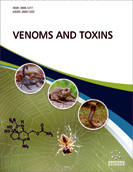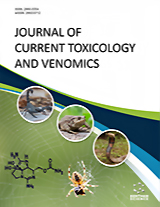Abstract
Background: Fungi of the genus Lactarius Pers. before the maturation of spores are not damaged by microorganisms, insects, mollusks, and animals. Such resistance correlates with the period when the basidiomes of these fungi are filled with milky juice, which contains substances of various chemical nature that provide their protection.
Objective: The aim of our work is to present the results of our recent and previously published studies on the identification and toxicological characteristics of substances available in the milky juice of fungi of the genus Lactarius Pers and used for protection against predator and parasite organisms. The possibility of using these substances to suppress tumor cells is also discussed.
Methods: The biological effect of the juice of L. pergamenus, L. quietus, and L. volemus, as well as methylene chloride, extracts obtained from fresh, frozen and dried basidiomes of L. pergamenus was studied. Purification of individual fractions of hexane extract from the basidiomes was performed by chromatography on a silica gel column and their analysis by done by thin layer chromatography and gas chromatography mass spectrometry.
Results: The sesquiterpene aldehydes were shown to be the main component of the chemical protection system of Lactarius. These agents are present in the milky juice of the Lactarius fungi, and they are easily oxidized by oxygen in the air. The milky juice of these mushrooms is also rich in higher fatty acids and phthalates. Phthalates possess an insecticidal effect, while higher fatty acids are capable of forming adducts with sesquiterpenes that provide emulsion stability. Water-soluble substances, in particular, the polyphenol oxidase enzyme, whose activity correlates with the content of milky juice in basidiomes, also play a protective role.
Conclusion: Milky juice of mushrooms of Lactarius Pers. genus is a stable balanced emulsion containing a large number of substances. One part is responsible for the toxic effects on other organisms, while the other part determines the chemical stability of the emulsion. Altogether, they create an effective system of protection of fungi of the Lactarius genus against microorganisms, insects, mollusks, and animals.
Keywords: Lactarius Pers., sesquiterpenes, phthalates, polyphenol oxidase, fatty acids, chromatography, gas-chromatography, mass spectrometry.
[http://dx.doi.org/10.1007/s42690-021-00692-4]
[http://dx.doi.org/10.1016/S0040-4020(01)90201-7]
[http://dx.doi.org/10.1021/np50038a013]
[http://dx.doi.org/10.1007/s11101-011-9216-2]
[http://dx.doi.org/10.1007/s43188-020-00054-1] [PMID: 33868977]
[http://dx.doi.org/10.15407/biotech8.02.058]
[http://dx.doi.org/10.1016/S1572-5995(05)80084-5]
[http://dx.doi.org/10.1038/ja.2005.60] [PMID: 16161484]
[http://dx.doi.org/10.15407/ubj85.05.170]
[http://dx.doi.org/10.1134/S0006297911040067] [PMID: 21585319]
[http://dx.doi.org/10.1002/ardp.19693020208]
[http://dx.doi.org/10.17721/moca.2020.125-131]
[http://dx.doi.org/10.1002/jssc.201400119] [PMID: 24520052]
[http://dx.doi.org/10.3891/acta.chem.scand.47-0403]
[http://dx.doi.org/10.15407/ubj87.02.056] [PMID: 26255339]
[http://dx.doi.org/10.3891/acta.chem.scand.52-1333]
[http://dx.doi.org/10.17221/524/2010-CJFS]
[http://dx.doi.org/10.1007/s13659-017-0130-1] [PMID: 28493207]
[http://dx.doi.org/10.1016/S0040-4039(00)87218-4]
[http://dx.doi.org/10.1016/0031-9422(94)00875-T]
[http://dx.doi.org/10.32094/HERB-2018-06]
[http://dx.doi.org/10.1016/0031-9422(94)00781-N]
[http://dx.doi.org/10.3184/174751917X15021050367558]
[http://dx.doi.org/10.1201/9780203414569]
[http://dx.doi.org/10.1186/s43094-021-00197-4]
[http://dx.doi.org/10.2987/08-5837.1] [PMID: 19653498]
[http://dx.doi.org/10.4489/MYCO.2009.37.1.031] [PMID: 23983504]
[http://dx.doi.org/10.1186/1471-2164-12-524] [PMID: 22026506]
[http://dx.doi.org/10.1080/15287394.2021.1970065] [PMID: 34459359]
[http://dx.doi.org/10.1016/j.phytochem.2006.08.006] [PMID: 16973188]
[http://dx.doi.org/10.1016/j.jinorgbio.2008.08.007] [PMID: 18829115]
[http://dx.doi.org/10.1017/S095375629700436X]
 1
1




